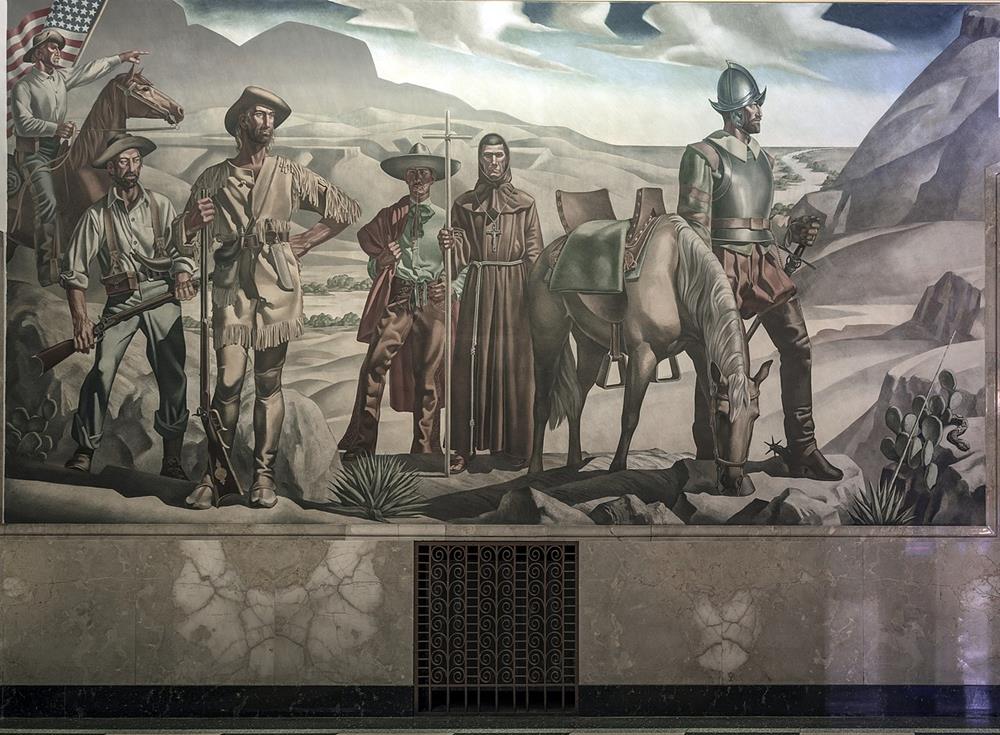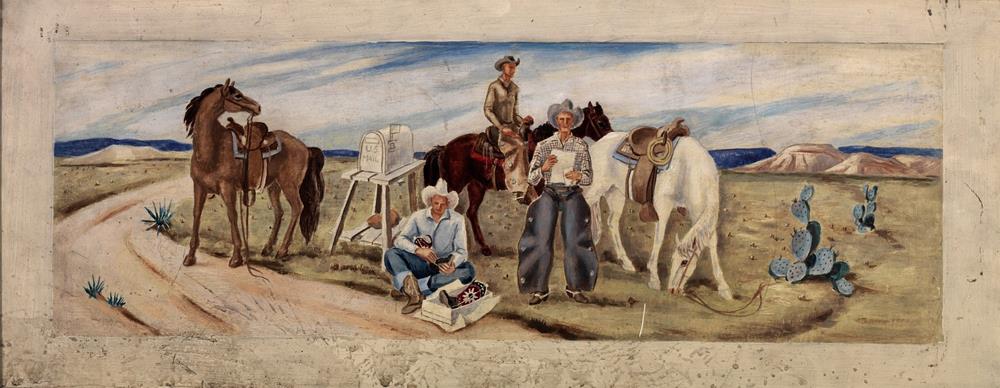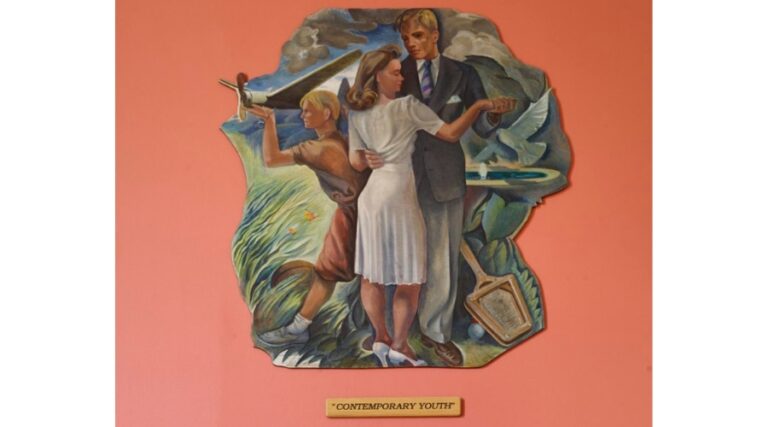During the Great Depression, art became a powerful tool for rebuilding hope. Across Texas, public buildings were transformed into galleries of everyday life through the New Deal art programs. Between the 1930s and 1940s, more than a hundred murals appeared in post offices, courthouses, and federal buildings statewide—each one telling a story about the people, landscapes, and industries that shaped Texas.
These works weren’t just decoration. They were designed to inspire optimism and civic pride at a time when both were in short supply. Today, the Texas New Deal murals stand as vibrant snapshots of history—connecting past generations with the values of hard work, resilience, and community.
The New Deal Art Programs in Texas
Under President Franklin D. Roosevelt’s New Deal, several federal art programs were launched to employ artists and enrich public spaces. The most influential for Texas murals was the Treasury Section of Fine Arts, which commissioned works for post offices between 1934 and 1943.
While the WPA Federal Art Project supported community art and teaching, the Treasury Section focused on permanent pieces celebrating local culture. In Texas, artists were encouraged to draw from real life—ranching, farming, oil, railroads, and the landscapes that defined the region. The result was a sweeping visual diary of the Lone Star State at a pivotal moment in its history.
Murals Across Texas: Highlights by Region

Commissioned vs. Proposed:
- Commissioned New Deal murals were funded by federal programs and installed in post offices or federal buildings
- Proposed / study works were designs, competition entries, or New Deal–era pieces that were not ultimately installed under a federal commission. The Bullock Museum features several of these insightful studies, which help us see artists’ ideas and process even when a proposal wasn’t selected.
Central Texas
Central Texas communities embraced stories of work, medicine, and migration—often rendered in a clear, Regionalist style. You’ll find installed post-office murals that honor pioneers, agriculture, and small-town life across the region.
- Commissioned highlights: Pieces in towns across the Hill Country and the northern edge of the Edwards Plateau often depict ranching, farming, and frontier scenes.
- Proposed / study connections (Bullock): See William Lewis Lester’s Mural Study with Scenes from the Alamo and Goliad Battles (c. 1936)—a dramatic, two-tiered narrative that reflects the historical themes favored by Central Texas commissions—even though this specific submission did not become an installed mural.
North Texas
From prairie crossroads to modern industry, North Texas murals trace the shift from trail to rail, and later to oil and aviation. Dallas and Fort Worth hosted major federal buildings that attracted ambitious designs.
- Commissioned highlights: Fort Worth’s federal courthouse includes a suite of installed murals from the New Deal era that spotlight frontier legends and state iconography.
- Proposed / study connections (Bullock): Thomas M. Stell’s Mural Study for Dallas Post Office (c. 1935) shows how artists composed bustling, multi-figure scenes for urban commissions; Stell later won New Deal projects in other Texas towns.
West Texas
Wide horizons and tough weather shaped West Texas imagery. Murals here celebrate cattle, wind, mesas, and the people who made a living from them.
- Commissioned highlights: In Alpine, José Moya del Pino’s View of Alpine offers a panoramic tribute to Big Bend country. In Big Spring, Peter Hurd’s work honors early settlers’ endurance—classic West Texas storytelling in paint.
- Proposed / study connections (Bullock): Edward C. Bearden’s Study for Mural (c. 1943) elevates the sawmill worker—an industrial theme that parallels many installed West- and East-Texas commissions focused on labor.
East & Gulf Coast Texas
Along the coast and Piney Woods, artists leaned into ship channels, refineries, timber, and the city-building that followed.
- Commissioned highlights: Installed works in port and refinery towns often foreground maritime trade, oil, and rail.
- Proposed / study connections (Bullock): Edna Gertrude Collins’s Mural Study, Oil Field Workers (c. 1944) captures the drama of oil work. Though Collins didn’t receive a federal post-office commission, her studies—and her mural for a state agency—mirror the industrial focus common in commissioned Gulf-Coast murals.
South Texas

South Texas murals frequently blend borderland history with ranch and farm life, reflecting deep cultural ties across the Rio Grande.
- Commissioned highlights: Installed works in South Texas towns often portray community festivals, ranch scenes, and regional histories—sometimes in multi-panel formats.
- Proposed / study connections (Bullock): Otis Dozier’s Untitled (Mural Study) (c. 1939) and Colonizers and Filibusters (c. 1937) reveal how he developed narrative sequences about settlement and identity; Dozier later executed multiple commissioned New Deal murals elsewhere in Texas.
Why this Distinction Matters
For travel planning or research, commissioned murals point you to artworks you can still visit in federal buildings or local repositories. Studies and proposals—like those preserved by the Bullock—enrich the story: they show the ideas that circulated among Texas artists during the New Deal and how subjects evolved from sketch to wall.
Style, Symbolism, and Legacy
Most Texas New Deal muralists embraced a style known as Regional Realism—a blend of realistic detail and poetic storytelling. They portrayed ordinary people as heroes of their own communities: farmers in fields, cowhands at work, teachers in classrooms, and families at prayer.
Though modest in scale, the murals conveyed profound messages about endurance and cooperation. They also captured the landscapes that define Texas—from Panhandle prairies to Gulf marshes.
Today, their legacy endures through ongoing restoration projects and museum exhibitions that keep these public masterpieces alive for new audiences.
Where to See Them Today
Many of the New Deal murals still hang in Texas post offices, where they quietly greet locals running everyday errands. Others have been moved to preservation sites such as the Smithsonian American Art Museum or the Bullock Texas State History Museum, which curates the state’s most complete digital collection of New Deal–era murals.
Whether in a courthouse hallway or an online exhibit, each mural remains a window into the hopes and hardships of Depression-era Texas—a living reminder that creativity can thrive even in times of great challenge.
Conclusion: Texas Stories in Color
The New Deal murals of Texas are more than historic artifacts; they are stories painted in resilience. They tell of communities that refused to fade, of workers and artists who found purpose in collaboration, and of a state whose identity was shaped not only by its vast land but also by the people who called it home.
As you travel across Texas—or explore the Bullock Museum’s collection online—take a moment to look up. You may find that a forgotten mural is still telling its story, one brushstroke at a time.


